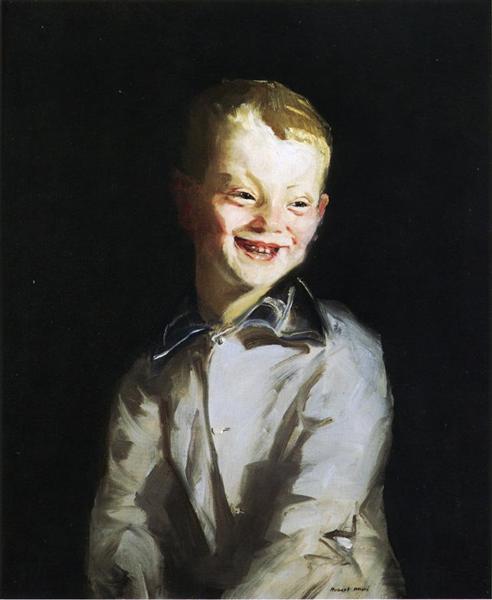Description
The work "The child who laughs (Jobie)" by Robert Henri, painted in 1910, is a captivating portrait that captures not only the vivacity of a child, but also the vibrant spirit of childhood. Henri, who was one of the main exponents of the school of artists known as the Ashcan School, had an approach that focused on urban life and everyday moments. However, in this particular work, there is a more intimate and personal connection, far from the bustle of the city, in a genuine exploration of the child's joy and spontaneity.
The composition of the paint is remarkably direct. The child, Jobie, occupies the center of the canvas, which instantly draws attention to his open and smiling expression. Henri moves away from excessive ornamentation, focusing on the figure of the child, whose face shines in a genuine and contagious laugh. The inclination of the head and the position of the arms seem to transmit movement, which gives life to the image and allows the viewer to almost listen to the child's laugh. The choice of a neutral background helps Jobie stand out even more, emphasizing his uniqueness and the intensity of his expression.
The use of color in this work is equally significant. Henri uses a warm and rich palette, with golden tones that accentuate the child's skin and provide a bright shine to his face. These colors are complemented with subtle shadows that add depth and volume, making Jobie's representation almost three -dimensional. The light blue of his shirt contrasts harmoniously with the warm tones of the background and his skin, which also contributes to the sensation of freshness and vitality.
Henri's style, characterized by the loose and expressive application of the paint, manifests itself in the way in which each brushstroke seems to be impregnated with energy. Unlike the most formal and elaborate portraits of his time, "the child who laughs (Jobie)" feels like a fleeting capture, almost a sketch, but at the same time, it is a completely finished work that talks about the essence of the essence of childhood. The light texture of the painting suggests that Henri was looking for an emotional connection with the viewer, inviting him to resonate with the pure joy that emanates from Jobie.
Through "the child who laughs (Jobie)", Henri offers a reflection on the purity of childhood and the beauty of simple moments. Not only has a portrait, but it creates almost a visual narrative that evokes the innocence and happiness that are often found in the small details of life. In this sense, it is a tribute to child spirit, free of concerns and full of joy, reminding us all of the importance of assessing those little sparks of happiness in our daily lives. The work is a testimony of Robert Henri's talent to portray humanity in its most authentic form, a legacy that continues to resonate in contemporary art.
KUADROS ©, a famous paint on your wall.
Hand-made oil painting reproductions, with the quality of professional artists and the distinctive seal of KUADROS ©.
Art reproduction service with satisfaction guarantee. If you are not completely satisfied with the replica of your painting, we refund your money 100%.

